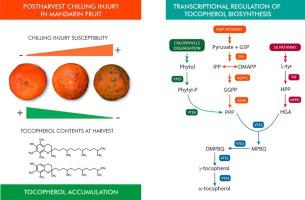Postharvest Biology and Technology ( IF 7 ) Pub Date : 2021-05-29 , DOI: 10.1016/j.postharvbio.2021.111594 Florencia Rey , María Jesús Rodrigo , Lorenzo Zacarias

|
Tocopherols are plant-derived isoprenoids with potent antioxidant activity, which have been implicated in the tolerance of plants to different stresses. However, tocopherol accumulation and biosynthesis in fruit, and their potential implication in postharvest chilling injury (CI), has been scarcely studied. Therefore, in this work, we have investigated tocopherol accumulation and biosynthesis in the peel of mandarin fruit of three cultivars with contrasting susceptibility to CI during storage at 2 °C (‘Fortune’>‘Nova’> ‘Nadorcott’). α- and γ-tocopherol were the isoforms detected in the flavedo of the fruit, and a direct relationship between tocopherols content and CI-tolerance was found, since CI-tolerant fruit accumulated the highest tocopherol content whereas CI-sensitive fruit the lowest. Moreover, the transcriptional profiling of 14 genes related to the specific steps of tocopherol biosynthesis, and to their precursor’s synthesis, were analyzed. Upstream genes DXS1 and DXS2 (1-deoxy-d-xylulose-5-phosphate synthase) and GGDR (geranylgeranyl diphosphate reductase), involved in the supply of phytyl pyrophosphate, and the VTE3 (2-methyl-6-phytyl-1,4-benzoquinol methyltransferase) isoforms appear to be key for the differences in total tocopherol content among the cultivars at harvest. During cold storage, most genes involved in the precursors supply were up-regulated, whereas genes of the tocopherol-core pathway were in general repressed. Changes in VTE4 during cold storage may account for the differences in γ-tocopherol among cultivars. Collectively, results suggest that the concentration of tocopherols at harvest may play a function in the natural tolerance of mandarin fruit to CI, and that changes in the expression of genes during storage appear to be cold-regulated responses, rather than involved in CI tolerance.
中文翻译:

柑橘冷藏过程中生育酚的积累及其生物合成的转录调控
生育酚是植物来源的类异戊二烯,具有强大的抗氧化活性,与植物对不同胁迫的耐受性有关。然而,生育酚在果实中的积累和生物合成,以及它们在采后冷害 (CI) 中的潜在影响,几乎没有被研究过。因此,在这项工作中,我们研究了三个品种的柑桔果皮中生育酚的积累和生物合成,与在2°C下储存期间对CI的敏感性相反(“财富”>“ Nova”>“ Nadorcott”)。α- 和 γ-生育酚是在水果的果皮中检测到的同种型,并且发现了生育酚含量与 CI 耐受性之间的直接关系,因为 CI 耐受水果积累的生育酚含量最高,而 CI 敏感水果的含量最低。而且,分析了与生育酚生物合成的特定步骤及其前体合成相关的 14 个基因的转录谱。上游基因DXS1和DXS2(1-脱氧d -xylulose -5-磷酸合酶)和GGDR(香叶基香叶基二磷酸还原酶),参与植基焦磷酸的供应,和VTE3(2-甲基-6-植基-1,4-苯醌甲基转移酶)同种型似乎是收获时品种间生育酚总含量差异的关键。在冷藏期间,参与前体供应的大多数基因被上调,而生育酚核心途径的基因通常被抑制。VTE4 的变化冷藏过程中的γ-生育酚可能是不同品种间存在差异的原因。总的来说,结果表明收获时生育酚的浓度可能在柑橘果实对 CI 的自然耐受性中发挥作用,并且储存期间基因表达的变化似乎是冷调节反应,而不是参与 CI 耐受性。



























 京公网安备 11010802027423号
京公网安备 11010802027423号